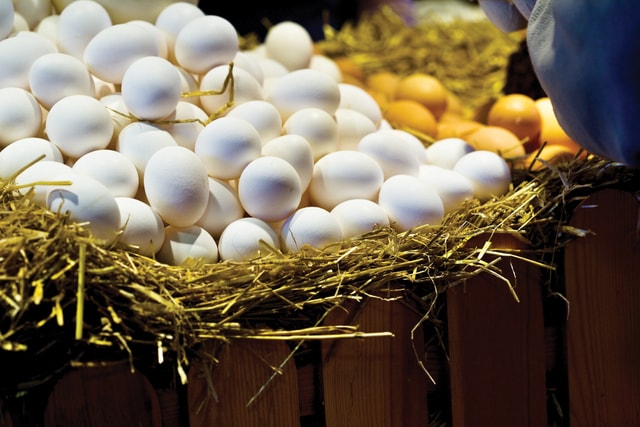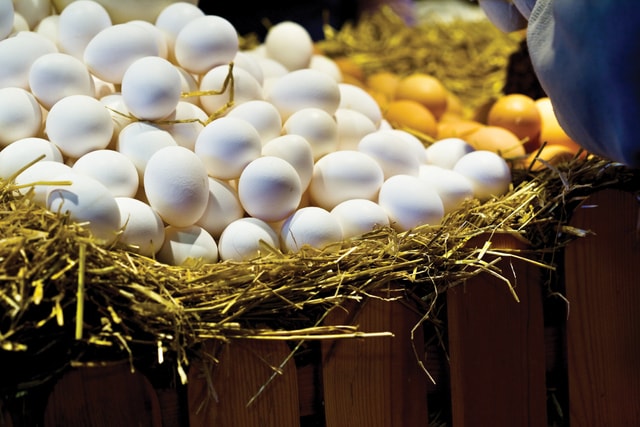

DARKE COUNTY – The Coalition for Sustainable Egg Supply has worked with egg farmers and retailers over the past three years to study several factors involved in egg production, with an emphasis on ensuring food safety and affordability, and the results showed that the lowest cost and highest producing method of egg production also had the lowest hen mortality.
“Consumer interest in how hens are housed has been growing, “said Darrin Karcher, Extension Specialist in the Department of Animal Science at Michigan State University and CSES Project Director, in a release about the study. “However, good science-based information about the sustainability of various hen housing systems and egg production has not been available on a commercial scale.”
Flocks of hens were studied at Michigan State University, the University of California-Davis and other locations in three different types of housing environments: conventional, enriched colony and cage-free.
Conventional cage housing is the method used in 95 percent of egg production in the United States. In this system, six to nine laying hens share space. Hens are housed indoors in barns with multi-level rows of cages with wire mesh floors. The cages are equipped with waterers and a feed belt for a constant supply of fresh food and water, and waste is automatically removed via manure belt management system, which keeps the manure away from the birds.
Enriched colony housing also keeps birds indoors in barns with multi-level, mesh floored cages. In this system, there is more space to ensure birds have room to turn around, sit, stand and extend their wings. The colonies also provide hens with access to areas that allow for specific bird behaviors, including perching, scratching, dust bathing and nesting. This system also includes the food, water and manure management of a conventional system.
In a cage-free aviary, hens have access to multiple levels with areas conducive to natural bird behaviors, such as perching, scratching, dust bathing, foraging and nesting. The hens are housed indoors but are able to move about the barn within defined areas, including floor space bedded with wood shavings. They have constant access to fresh food and water, and the belt manure management system is located beneath the mesh floor.
Hen housing of all three types varies from farm to farm. In the test cases, conventional systems offered 80 square inches of space per bird. Enriched has 116 square inches per bird, and aviary had 144 square inches.
Over the three-year study, researchers measured and compared five different sustainability factors in each housing system: animal health and well-being, food safety and quality, the environment, worker health and safety, and food affordability.
Researchers found positives and negatives with every system, but overall, eggs produced in conventional cage housing had the lowest cost of production, the lowest hen mortality and required the least labor to maintain.
“With these science-based research results, we have a better understanding of hen housing sustainability,” Karcher said. “Consumers can use this information to make informed purchasing decisions that best align not only with their values about how hens should be housed, but also their grocery budgets.”
According to the National Agricultural Statistics Service’s monthly Chicken and Eggs Reports, United States shell egg production was down 9 percent from last year in June and down 10 percent from last year in July.
The table egg flock size on May 1, 2015, was 296 million layers, but by July 1, the flock had dropped to 269 million layers because of avian flu outbreaks. That number rose to 271 million by Aug. 1.
Iowa remains the top egg-producing state, with Ohio in second place, but the impact of avian flu has been heavy in Iowa, while Ohio has remained largely untouched. According to the World Agricultural Supply and Demand Estimates Report, in June, Iowa had approximately 43,007,000 laying hens but in July, that number was down to 33,236,000. In Ohio, the population of layers actually rose from June to July by almost 300,000 birds.
The Coalition for Sustainable Egg Supply includes leading experts in animal welfare, academic institutions, non-government organizations, egg suppliers, restaurants and food retailers.
To view the complete results of the study, visit www.sustainableeggcoalition.org.





